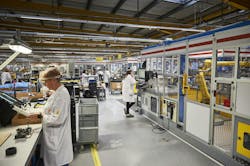A high-end construction equipment manufacturer unifies previously siloed processes and manual hand-offs with a digital approach that supports concurrent engineering and manufacturing planning, resulting in a 30% drop in misconfigured products, a 14% spike in efficiencies and faster time to market.
A tire manufacturer cuts downtime on its production lines, ensuring more than a half million additional tires are pumped out each year.
Meanwhile, a premium car brand saves millions of electric kilowatt hours by optimizing plant tooling and machine utilization.
The transformation journeys at these companies and the technologies they’ve used to achieve these results. have differed, but this trio of manufacturers is chasing a common goal: Creating a digital thread that connects data, critical systems and workflows to drive intelligent decision-making and automation decisions while powering more efficient and profitable business.
Though it’s still an evolving concept, the digital thread builds on digital twin technology to connect granular, digital data about engineering and product design, plant floor equipment, manufacturing operations, supply chain processes and service histories. These data already exist in paper-based work instructions or tucked away in core enterprise systems like MES (manufacturing execution system), ERP (enterprise resources planning), and PLM (product lifecycle management). The goal of the digital thread is to provide the connective tissue and universal data access so that all workers—from plant floor operators to field support specialists—operate from the most current and relevant playbook.
As PTC defines it, the digital thread closes the loop between the physical and digital worlds, enabling enterprises to anticipate and effectively communicate bi-directionally up and downstream of where the product is in its lifecycle. The idea is to allow all participants engaged in a product’s lifecycle to utilize the most current data so they can react quickly to changes or new insights.
According to a global survey conducted by PTC and Accenture on the State of the Digital Thread, nearly three quarters of engineering, manufacturing, service and IT leader respondents said that improving the ability to leverage data across all facets of the enterprise would be effective or highly effective in helping companies address market disruptions.
“The digital thread democratizes data from all systems, at the edge or in the cloud, providing the larger organization access,” explained Joe Gersti, director of MES product management, Proficy software, at GE Vernova. “Improving visibility and availability of data ensures it can be used to unlock business value throughout all parts of the organization.”
The concept of a digital thread may be relatively new, but the desire to sync up siloed systems and leverage data for actionable insights is not. “The thread has always been there, but it hasn’t been digital,” said Keith Chambers, vice president of manufacturing solutions at Aveva, a provider of industrial software. “We’ve been trying to connect these pieces together for a while—what’s new are the capabilities for optimizing at every step and the fact that it’s responsive and proactive whereas it used to be very transactional.”
Digital thread building blocks
There’s no magic formula or quick solution to building a digital thread nor is there any one tool used to establish the connective tissue. More important to most manufacturers is that there’s no need to exclude legacy technologies from the mix—most existing plant floor systems and assets can participate and add value to a digital thread if they are digitalized, there’s proper planning around their role in the digital thread and a focus on using open systems to connect it all.
“Open systems make it easier to connect to legacy systems and that’s the reality we operate in,” said Dale Tutt, vice president of industry strategy at Siemens Digital Industries Software. “A lot of companies don’t have the luxury of a greenfield situation—they require transformation elements that can grow from with them.”
There is also no singular view of where the digital thread begins (it varies by vendor), yet there is consensus that the mission involves integrating data and workflows between the core systems of MES, ERP and PLM.
For PTC, the digital thread backbone is PLM, a platform it has long positioned as being the single source for product data. Decades into PLM deployments, PTC now acknowledges that narrative didn’t manifest, as product data is inevitably spread across MES, field service, quality systems and other platforms. “Product information exists in different forms in different systems and the idea is to connect them via this digital thread that ensures forward propagation of data,” said Kevin Wrenn, PTC’s chief product officer. “If changes happen, everything is updated.”
At Volvo Construction Equipment, for example, there was no commonality among product data shared across 11 factories, each having plant-specific bills of process, bills of material and work instructions. Though a digital thread constructed across Windchill PLM and SAP ERP and MES, as well as other data sources, the construction equipment manufacturer is now better managing the high rate of change in its complex machinery configurations, ensuring parts can be assembled as designed, analyzing equipment and tools to understand how changes might impact production and enabling continuous improvement through virtual testing and evaluation.
“In the end, customers that are doing this well are looking for the same thing—they want more efficiency and throughput in both engineering and manufacturing, they want to improve first pass yields, they are looking to reduce scrap and cost of goods sold and they want to ensure better asset utilization in factories,” Wrenn said.
Data is the critical fuel for the digital thread, and companies are producing more and more of it as sensors are connected to industrial equipment and processes as part of industry’s ongoing digital transformation. Data is central to driving insights that help companies decide whether to make supplier changes, address anomalies causing quality issues, or perform proactive and condition-based maintenance based on key performance indicators to keep production running smoothly.
While manufacturing operations data are abundant, much of it is tied to a single vendor ecosystem and lacks the proper context to make it easily actionable for stakeholders, according to Petter Mörée, managing director, EMEA at Iota Software, which makes data visualization software to connect people, assets and manufacturing processes.
Iota’s software, called Vue, fits into the digital thread concept by providing a framework to understand both the product and the equipment and tools used to create it, employing tags and structure to create better context, Mörée says. “We are enabling connection, contextualization, and the meaning of the data then translating it in a way that can be easily understood to manage the lifecycle of systems,” he explained. “If you don’t have such an approach, it’s difficult to derive any meaning from the data that you have available.”
Best practices for success
With so many digital thread technology building blocks in place, organizations need to take a step back and devise a holistic strategy to tie everything together and align efforts to key pain points. The standard approach is to focus efforts on an area of need—perhaps an MES to drive continuous improvement on the shop floor or a PLM platform to streamline change orders and speed time to market. While those are highly effective starting points for a digital thread strategy, the initial projects need to be executed in the context of the broader digital enterprise otherwise manufacturers simply end up with more silos, said Siemens’ Tutt.
“Focus on the where you have business challenges you need to solve now and get wins, but have the conversation in the broader context,” he said. “You’re not just investing in MES or manufacturing plant simulation to solve today’s problems, but rather planning for the future. Buying a solution without thinking about where it takes the company [towards digital thread goals] makes the transition harder down the road.”
Focusing on the technology vs. the value a digital thread delivers is a mistake many companies make. Manufacturers also start off too foundational without denoting a specific payback period or plan for delivering value along the way.
“Executives get scared away if you’re not demonstrating return on investment or if programs stall out,” said Stephen Birtsas, director at Kalypso, a Rockwell Automation business with a focus on consulting services. “Make sure you have the appropriate value drops as you work towards longer-term strategic goals.”
Once your digital thread pieces are in place, attention needs to turn to operationalizing and scaling efforts. For example, advanced analytics that leverage artificial intelligence for predictive insights are great, but if the insights aren’t connected back to everyday workflows, the digital thread benefits are lost. “If you have a super fancy model that needs a data scientist to run it and you’re not doing anything to bring those insights into how operators do their jobs every day, it’s not helping,” said Aveva’s Chambers.
At the same time, once those insights have impact on everyday plant floor operations, it’s crucial to plan for scaling initiatives to other areas and eventually other plants. Doing so requires a major commitment to shifting culture and change management practices to get stakeholders at all levels on board.
“These are major changes for major manufacturing functions that are used to doing the same thing they’ve been doing for decades,” PTC’s Wrenn said. “Manufacturers have to adopt new processes and methods, and the partnership between engineering and manufacturing must be repaired.”
The digital thread can be an effective way to achieve this.



